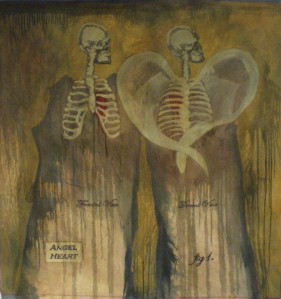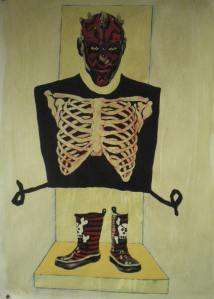MOBY’S DICK
March 27, 2011
In Herman Mellville’s epic novel Moby Dick, he describes an apron worn by ‘The Mincer’ made from the ‘Grandissimus’ of the whale.

Apron Reversed
‘The Cassock’
Had you stepped on board the Pequod at a certain juncture of this post-mortemising of the whale; and had you strolled forward nigh the windlass, pretty sure I am that you would have scanned with no small curiosity a very strange, enigmatical object, which you would have seen there, lying along lengthwise in the lee scuppers. Not the wondrous cistern in the whale’s huge head; not the prodigy of his unhinged lower jaw; not the miracle of his symmetrical tail; none of these would so surprise you, as half a glimpse of that unaccountable cone, longer than a Kentuckian is tall, nigh a foot in diameter at the base, and jet-black as Yojo, the ebony idol of Queequeg. And an idol, indeed, it is; or, rather, in olden times, its likeness was. Such an idol as that found in the the secret groves of Queen Maachah in Judea; and for worshipping which, king Asa, her son, did depose her, and destroyed the idol, and burnt it for an abomination at the brook Kedron, as darkly set forth in the 15th chapter of the first book of Kings.
Look at the sailor, called the mincer, who now comes along, and assisted by two allies, heavily backs the grandissimus, as the mariners call it, and with bowed shoulders, staggers off with it as if he were a grenadier carrying a dead comrade from the field. Extending it upon the forecastle deck, he now proceeds cylindrically to remove its dark pelt, as an African hunter the pelt of a boa. This done he turns the pelt inside out, like a pantaloon leg; gives it a good stretching, so as to almost double its diameter; and at last hangs it, well spread, in the rigging, to dry. Ere long, it is taken down; when removing three feet of it, towards the pointed extremity, and then cutting two slits for arm-holes at the other end, he lengthwise slips himself bodily into it. The mincer now stands before you invested in the full canonicals of his calling. Immemorial to all his order, this investiture alone will adequately protect him, while employed in the peculiar functions of his office.
That office consists in mincing the horse-pieces of blubber for the pots; an operation which is conducted at a curious wooden horse, planted endwise against the bulwarks, and with a capacious tub beneath it, into which the minced pieces drop, fast as the sheets from a rapt orator’s desk. Arrayed in decent black; occupying a conspicuous pulpit; intent on bible leaves; what a candidate for an archbishoprick, what a lad for a Pope were this mincer!
FRENCH POLISHER:
As with many of the found objects used in my current work about archetypes in costume,’The Remains of Myth’, these aprons were bought in Deptford Junk Market. I’m always on the look out for materials such as paints or brushes and on this occasion came across a box of old materials used by a French Polisher; wood stains, varnishes and teak oil. Next to the box I was astonished to find a pile of hand made linen aprons which were obviously associated. These aprons were unusual in shape being longer and thinner than one would normally expect an apron to be, they also included rather shallow pockets and several strings to attach them to the body. On working on drawings of the aprons I became aware that there was a certain phallic appearance. In a strange way they reminded me of some wierd prophylactic, and if reversed the pocket resembled the prepuce. I later remembered the above passage from my favourite book, Moby Dick. A humorous passage which is at the same time coy and explicit. The slightly esoteric references to the Bible would seem to be a way of obscuring the true nature of what he is describing whilst at the same time elevating the subject to a higher plain.
The Remains of Myth
March 23, 2011
A series of works which examine the mythology of costume. Looking at Jungian Archetypes such as hero, virgin, father in order to dig up what remains in the twenty first century. Being Archetypes they of course will never completely vanish. The ways in which costume determines how we are seen and therfore how we present ourselves. Presented as text-book illustrations from Archaeology, Anatomy or Biology texts, the works take found objects of costume and stick them on plywood using all sorts of mixed media from pva to varnish and polish. The items are also burned, which gives them a random finish thus becoming remains. Moving on from my previous burning of wedding dresses these costumes include twenties slips, industrial aprons and most importantly children’s dressing-up costumes. Looking at how parents choose to dress their children; girls as fairies, princesses and angels; boys as devils, soldiers and pirates, these particular works attempt to deconstruct gender constructs in costume by the construction of both 2 and 3 dimensional art works. Lots of construction, deconstruction and destruction.








